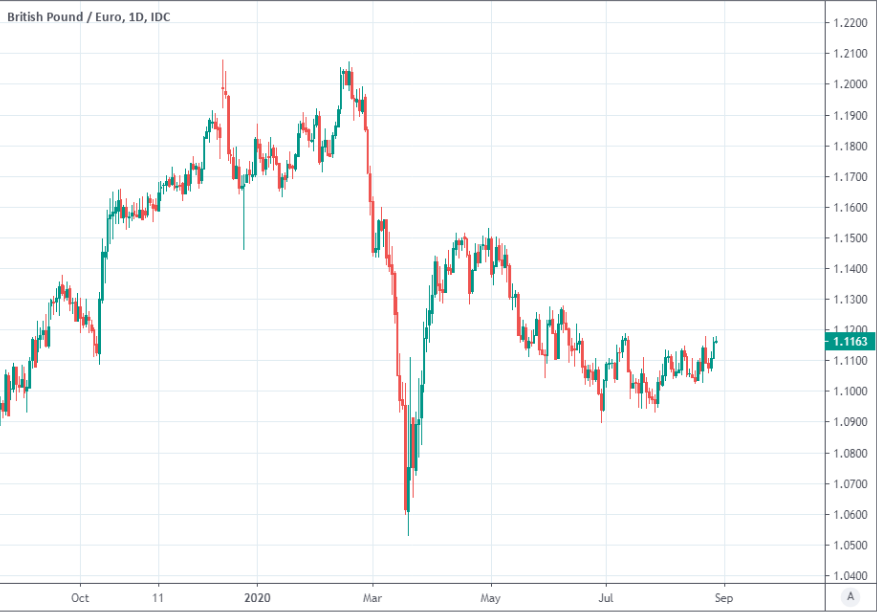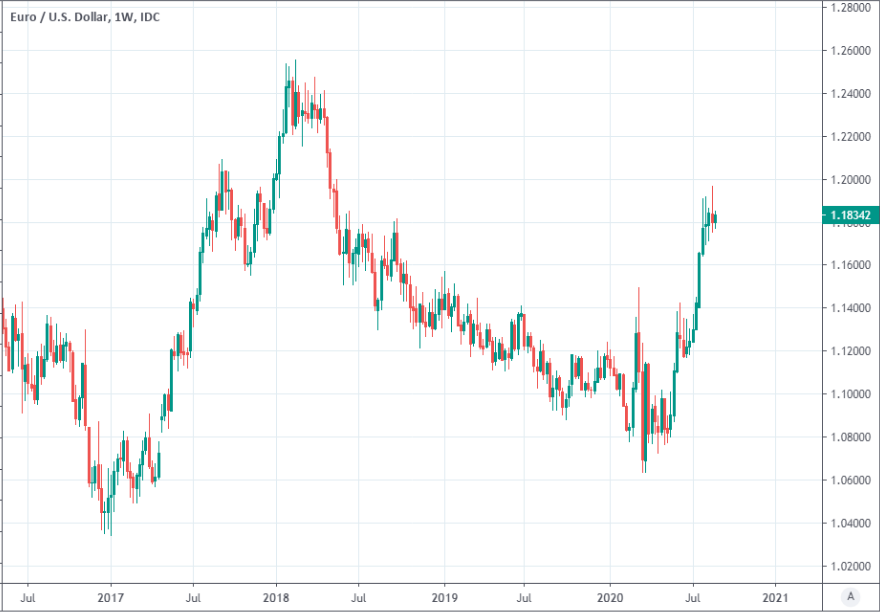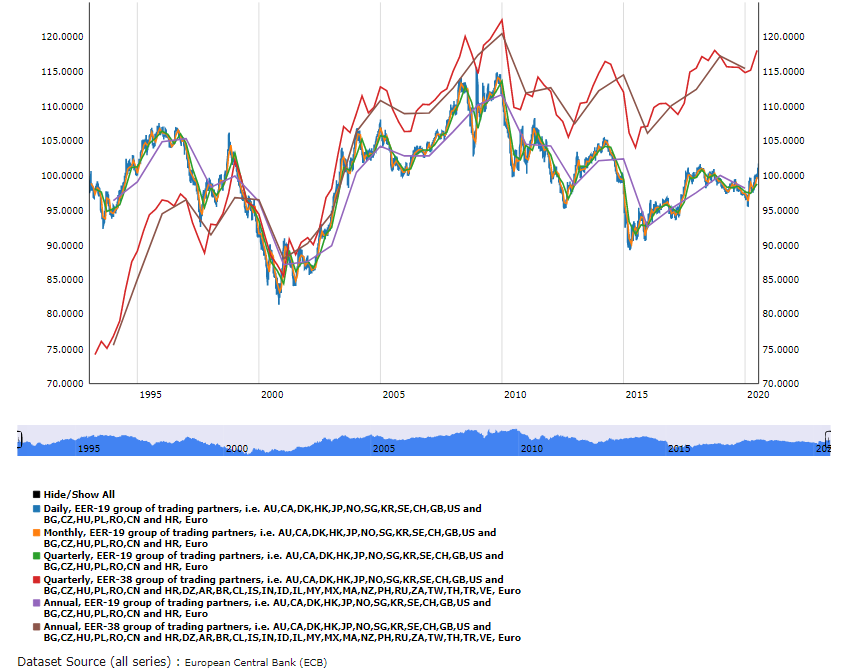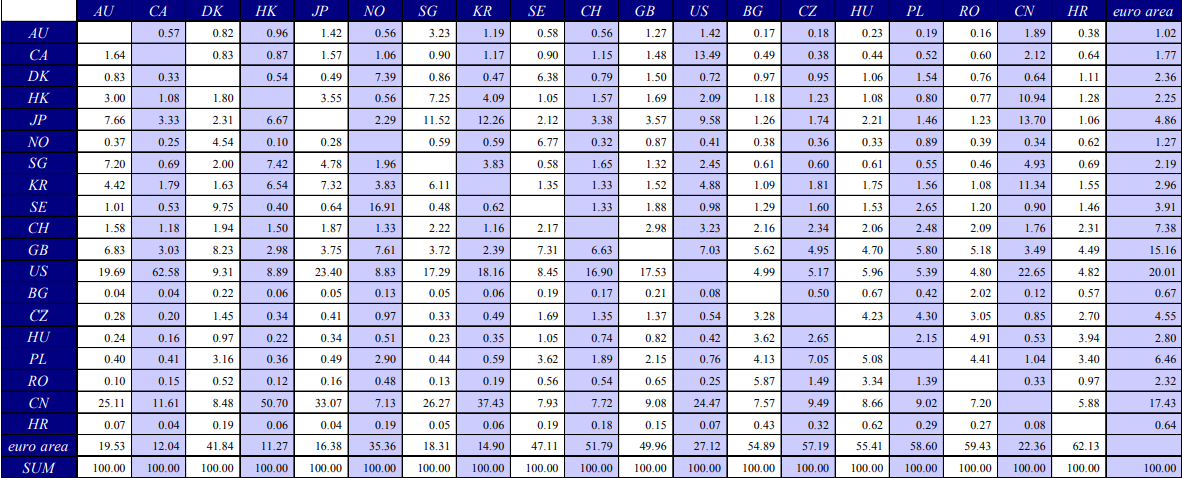Pound-Euro Rate Mulling Break Higher, Technical Analysts Say, as Tables Turn on the Charts
- Written by: James Skinner
- GBP/EUR in third day of gains and tipped to go higher.
- As advance toward 1.12 puts higher levels in pipeline.
- GBP/EUR gains may help keep EUR/USD rally alive.

Image © Adobe Images
- GBP/EUR spot rate at time of writing: 1.1167
- Bank transfer rate (indicative guide): 1.0876-1.0954
- FX specialist providers (indicative guide): 1.0999-1.1066
- More information on FX specialist rates here
The Pound-to-Euro exchange rate set itself on course for a third consecutive gain on Thursday and was tipped by technical analysts for an extended run higher amid an ebbing downtrend on the charts, with highs up near early June levels billed as possible for the coming days.
Pound Sterling was a middling performer against major counterparts after having gained over the Euro, Swiss Franc and Scandinavian currencies but ceded ground to the Dollar, Yen and the small commodity Dollars like the Aussie, Kiwi and Canadian Loonie.
Price action came ahead of an eagerly anticipated and possibly landmark address from Federal Reserve (Fed) Chairman Jerome Powell at a digital reincarnation of the Jackson Hole Symposium, an annual get-together and talking shop for the world's central bankers.
It also came amid a retrenchment of the Euro-to-Dollar rate, which has pulled back from highs last seen in early 2018 in the last week after IHS Markit PMI data incited doubts about the pace of the Eurozone economic recovery in August and as investors await details of Fed Chair Powell's speech at 14:10.
The Pound has softened against many currencies including the Dollar this week but EUR/USD has fallen -0.45%, enabling GBP/EUR to rise. Increasing numbers of analysts are now looking for this tentative rebound to extend further.
"Bounces should be limited in the short term given the weakness in daily volatility and as the daily stochastic turns lower. Thus, a return above a resistance at 0.9078 (daily Bollinger upper band) should prove difficult and we will prefer to watch support at 0.8958 (weekly Bollinger moving average). A break below this level would indeed release a strong bearish potential," says Micaella Feldstein, an analyst at Natixis, of the EUR/GBP exchange rate.

Above: Pound-to-Euro rate shown at daily intervals.
Feldstein is looking for Sterling to take a run at 1.1286 against the Euro following any move above 1.1163, a level the Pound-to-Euro rate crossed over on Thursday, although she's also said there's scope for 1.1389 to be seen over the next seven-to-ten days.
Natixis says a Pound-to-Euro return toward the 1.1015 support level that's underpinned Sterling through August is now looking like a longshot. Others are also mindful of a potential period of outperformance for Sterling while some are betting on that being the case too.
"EUR/GBP is under pressure in the range and attention has once again slipped to the .8931 July low last week," says Karen Jones, head of technical analysis for currencies, commodities and bonds at Commerzbank. "A slide below the .8931 would target the June low at .8864."
Jones says a move above 1.1196 would open the door for Sterling to move up to 1.1281 and has advocated that Commerzbank clients bet on this outcome if prices around 1.1068 and 1.1098 are seen again in the coming days.
Pound-to-Euro rate gains may be a necessary evil if the Euro rally of 2020 is to endure further given the impact that resurgent Euro-to-Dollar rate has had on the Eurozone trade-weighted currency.

Above: Euro-to-Dollar rate shown at weekly intervals.
The 6.48% rise seen in EUR/USD thus far in 2020 has, when combined with an even larger 6.8% increase in EUR/JPY, lifted the trade-weighted single currency back to levels seen in 2017 when the Euro rallied by a double-digit percentage from 1.06 in April to near 1.20 against the Dollar by year-end.
"We find that an exogenous 10% trade-weighted Euro appreciation typically reduces real GDP and consumer prices each by around 1% after two years. This rule of thumb implies that the appreciation so far might lower growth and inflation by about ¼ percentage point in each of the next two years. Our markets team’s expectation for further appreciation would roughly add a tenth to the drag on growth and inflation over this horizon," says Sven Jari Stehn, chief European economist at Goldman Sachs.
An elevated trade-weighted index is an headwind for the export-heavy Eurozone economy as it seeks to recover from the collapse brought on by government attempts to contain the pneumonia-inducing coronavirus, and it's also a disinflationary headwind for an inflation-targeting European Central Bank (ECB).
The ECB has rarely met its inflation target of "close to, but below 2%" since the financial crisis and more so if core inflation, which normally garners more attention from the market, is taken as the more appropriate measure.
In other words, Euro strength could soon become a concern for the ECB, which may in turn restrain the single currency unless there's an offsetting adjustment elsewhere. The Pound-to-Euro rate accounts for 15% of the Eurozone trade-weighted index and is one place such adjustment could come from.
Above: ECB estimates of Euro relative to 19 largest Euro area trading partners and 38 largest trading partners. Blue and yellow lines show higher frequency estimates testing 2017 highs while brown and purple lines show lower frequency measures rising back to pre-ECB quantitative easing highs. Estimates dated July 01, 2020.
"On a trade-weighted basis, the Euro is up by about 5% since March, while the Euro has appreciated around 10% versus the Dollar. Our markets team expects the Euro to strengthen further from here—to 1.25 against the Dollar in twelve months and roughly 2.5% on a trade-weighted basis—as we expect the Euro area economy to outperform other countries and see the Euro as under-owned in international portfolios and under-valuedin our fair value models," Stehn says. "EUR appreciation primarily reflects an improvement of the economic outlook and constructive institutional change in the Euro area’s fiscal architecture. The stronger Euro is, therefore, unlikely to be a significant concern for the ECB at this stage."
EUR/USD might rally further without lifting the trade-weighted index if EUR/JPY or EUR/CNH, both also large components, fell in the intervening period. But the Japanese Yen is underperforming and could continue doing so while the Chinese currency is managed by the state and could be likely to depreciate if tensions remain high between the U.S. and China.
Many analysts expect U.S.-China tensions to continue even if the White House incumbent loses November's election.
The Pound, on the other hand, is still seen by many as carrying a discount to 'fair value' for reasons relating to Brexit and trade talks with the EU are heading into their final stretch.
This and the above could mean the performance of the Euro will depend as much on the state of play in the Brexit negotiations as it does anything else.
Goldman Sachs anticipates "a ‘thin’ free trade agreement by the end of the transition period on 31 December" and forecasts a Pound-Dollar rate of 1.44 in 12 months and a Pound-Euro rate of 1.15 by that time, which coincides with the envisaged EUR/USD rate of 1.25. Others however, have warned of a bumpy path for Sterling in the near-term.
"Following the recent gains, we estimate that all risk premia has been priced out of GBP, with EUR/GBP currently trading at its short-term fair value. With high uncertainty about the outcome of EU-UK trade negotiations in place and the ongoing risk of a no deal, we see the current pricing as complacent and expect EUR/GBP to return above the 0.90 level in coming weeks," says Petr Krpata CFA, chief EMEA strategist for currencies and bonds at ING.
Above: European Central Bank graph showing respective trade-weightings of the Euro.






